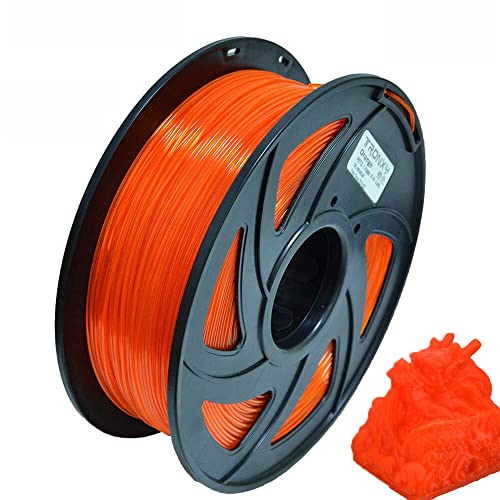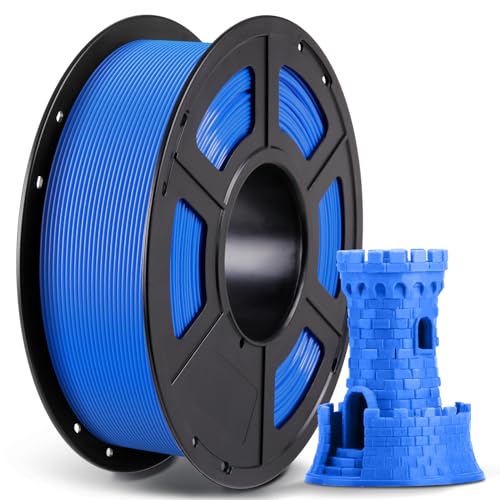The Best Filament for Ender 3 (2021) | Top Picks + Buyers Guide
3D printing has become more and more popular as time has gone on. With printers becoming more affordable and the materials needed to actually print out models being reasonably priced. It’s no wonder that there are now a ton of people that own a 3D printer. Plus with printers like the Creality Ender 3, people have a cheap and easy way to get into 3D printing without breaking the bank. But, for the most part, a lot of the money you’ll be spending won’t be on the printer itself but the filament. Learn how to get the most for your money with our Best Filament for Ender 3 Guide!




Table of Contents
Best Filament for Ender 3
Typically where the real cost of 3D printing comes from is with the filaments and any spare parts you’ll need when something inevitably breaks. And for a lot of people, this can definitely be a reason for not getting into 3D printing. But you don’t necessarily need to break the bank in order to get into the hobby. In fact, there are quite a few affordable options out there for things like filament. So we’ve gathered together a few of the best ‘The Best Filaments for the Ender 3 in 2021’. So let’s get right into it!
PETG 3D Printer Filament
For the first option on this list, we’ve gone for a cheaper filament that’s great for those that don’t want to spend too much money. We’ve chosen this filament from Tronxy for its low price and good quality. Typically when you get cheaper filaments you’re trading off quality for a lower price. And this can manifest in a lot of different ways but essentially, cheaper filaments make worse-looking models. For this filament, there is only one color option in the form of orange. Though if you like to paint your models this shouldn’t really be an issue. But if you would like the choice of having different colors of filament then you may need to look elsewhere.
First impressions with this filament are admittedly not great due to the poor packaging it comes in. But when it works correctly this filament produces high-quality models that have quite a lot of detail to them. It also makes models that are strong and robust due to the fact that it’s a PETG filament. But as it’s PETG filament it can also be a little bit tricky to use at times. And if your printer and bed are not set at the right temperature you may face issues. They recommend that your printer’s nozzle should be somewhere between 230°C to 250°C. Any lower than that and you could face issues with how the filament forms into a solid.
You may come across glooping or stringiness which would obviously not be ideal for 3D printing. As such this filament isn’t the best choice for beginners to 3D printing since there’s a lot more that can go wrong. But for those that want a cheap filament and know how to work with PETG, then this is a great deal.
Pros:
- Good Print Quality
- Affordable
- Makes Strong Models
Cons:
- Tricky to Use
- Limited Colour Options
ANYCUBIC 3D Printer Filament
Next up on our list, we’ve gone for a filament that offers a few different colors for you to choose from. We’ve gone for this filament from Anycubic for its affordability and choice of colors. This is another PLA filament and has the advantages that come with that. One of those advantages being a cheaper price than a lot of other kinds of filament. The colors that you can get this filament in are white, black, blue, red, and gray. So while it isn’t the most extensive lineup of colors, it covers the main ones that you may need. If you want a more varied choice of colors, check out some of our later options.
In terms of print quality, this filament does a great job. The prints that come out of it are highly detailed and well defined. Which makes it fantastic if you’re into making miniatures or figures that require a lot of detail. The filament itself is also neatly packed onto the spool so there shouldn’t be much of any risk of tangling when it’s in use. Though there have been reports that it’s too tightly wound so keep an eye out for this.
There have also been a few people that have struggled with the adhesion on this filament so also watch out for that. They recommend that the nozzle temperature should be between 190°C and 230°C while the bed should be between 50°C and 80°C. Figuring out the exact temperature that works for you is going to depend on lots of little factors. So do some tinkering and try out a couple of test prints to figure it out. Overall this is a great filament for people that want to save some money without skipping on the quality.
Pros:
- Great Print Quality
- Affordable
- Easy to Use
Cons:
- Brittle
- Fairly Limited Colour Options
/su_list]
OVERTURE PETG
For our final option on this list, we’ve gone for a filament that focuses on quality and delivers an excellent experience. We chose this filament from OVERTURE for its great quality prints and range of color options. This filament is pretty expensive and isn’t really what we’d recommend to anyone who is a novice at 3D printing. Plus this is also a PETG filament which is better suited in the hands of those who know how to use a 3D printer well. But for those that are interested in this option, there’s a lot here to like. The selection of colors being black, blue, green, light grey, orange, pink, purple, red, white, dark grey, and yellow.
For those who are looking for a filament that is more suited to functional things like clips or anything with moving parts, this might be the one for you. Since PETG filament is stronger than PLA in most cases it is much better suited for pieces that need to serve a functional purpose. They recommend that your nozzle temperature should be between 230°C and 250°C, while the bed should be between 80°C and 90°C. As soon as you’ve got those settings dialed in the filament should work correctly.
But if you aren’t experienced with PETG filaments you may need to tinker around to get the perfect settings for you. The models that come from this filament are strong and great for anything that needs to be functional. Since it’s expensive, newcomers to 3D printing should steer away from this option. And people who don’t use PETG very often may want to look elsewhere too. This filament does produce fantastic-looking models while being widely compatible and coming in a range of colors though. So 3D printing enthusiasts can’t really go wrong with this choice.
Pros:
- Fantastic Print Quality
- Wide Compatibility
- Large Colour Variety
Cons:
- Tricky to Use
- Expensive
Buying Guide
If you’ve been through this list and you still aren’t sure which filament is the one you should be getting, don’t worry! In this section, we’ll be giving you some extra advice and information to help you out with your purchase.
PETG filament VS PLA filament
PETG (Poly-ethylene terephthalate glycol) is a pretty common type of filament for FDM printers. About as common as PLA (Poly-lactic acid) tends to be, yet the two kinds of filament have quite a few differences. PLA tends to be cheaper and easier to use in most cases. Which is why it’s recommended that beginners to 3D printing stick with this type. Since you’re much less likely to run into any filament related issues. PETG is more favourable to experienced printers due to the fact that it produces stronger, well defined prints. So it’s better suited to prints that are going to be used for tougher jobs or items that have more of an active function to them.
But PETG filament is harder to work with during the printing process. Since it is a stronger material, that can have an adverse effect on the finish of the end product. Issues like stringiness can occur which can make your printed item look very ugly. And the process of cleaning and preparing the item at this point could be time consuming and ultimately not worth the time investment. Though in the right hands PETG can also be a fantastic material to work with. Since it can create stronger models at the end of the day and that’s extremely important for some prints.
How does 3D printing work?
The Creality Ender 3 is a very accessible printer for most people. And a lot of beginners may be starting their journey of 3D printing with it. So for those people here is a short guide that goes into the process of 3D printing. And it’s an interesting process to look into, though it has quite a few steps.
- AutoCAD
- FreeCAD
- Autodesk Revit
- Solidworks
There’s tons of software out there and a lot of it is pretty good and will do what you need it to. Now the performance of your PC is going to be what decides how well these programs run. It’s important that your specs either meet the recommended requirements or exceed them. The last thing you want is to wait a lifetime for the software to open, get stuttering every 30 seconds and finally after about an hour your printing. No one wants that, so let’s use the Solidworks system requirements as a gauge:
- Windows 10
- 16GB RAM (minimum)
Or
- 32GB RAM (recommended)
- At least 20GB of free space on a hard drive or SSD
- 4GB VRAM
So these requirements are not the most taxing in the world and chances are that you already have a good enough PC to run something like Solidworks. But if you don’t there are numerous ways of getting a machine with these specs for a decent price. After you’ve done all of that, you’re ready to get started with some printing.
Tips:
- PLA filament is a bit more common than PETG and it’s also easier to use. Though the trade-off is that it’s more fragile than PETG. So if you’re making models that are more for a show like figures or statues stick with PLA. If you’re making things that are going to have a more functional use, stick with PETG.
- Most PETG filaments you can get are compatible with a wide variety of printers. It’s pretty rare to find a filament that is not compatible with your FDM printer but it can happen. So be sure to double-check if your printer will accept it or not.
- If you’re a complete novice to 3D printing and you want to try out PETG filament, make sure you follow the instructions on how to use it properly. And prepare to do a few test prints to finger out the best settings for your prints.
Verdict - The Best Filament for Ender 3
That’s that for our list for The Best Filament for Ender 3. If it helped you out at all be sure to let us know about it in the comments below! Thanks for reading.









